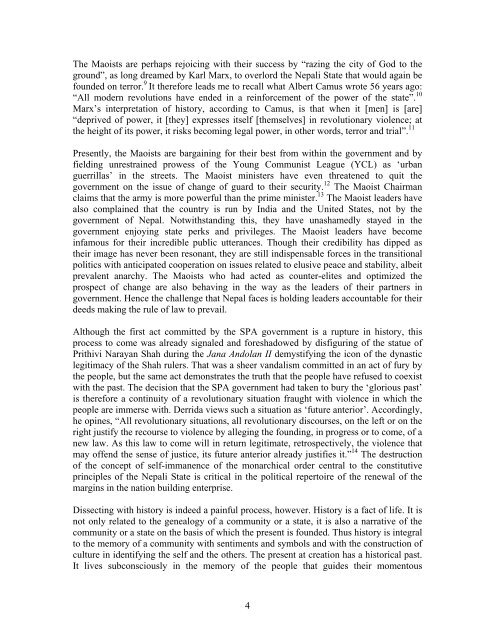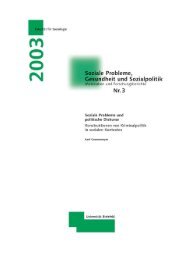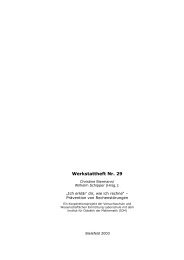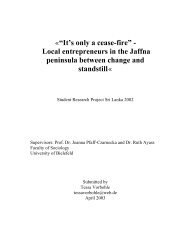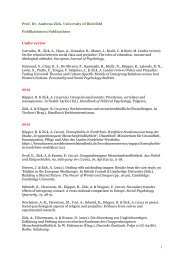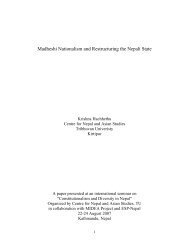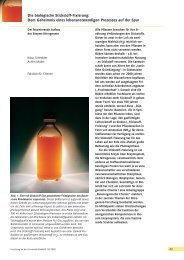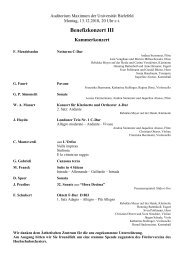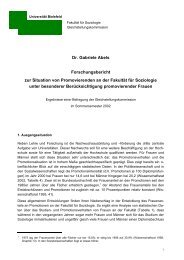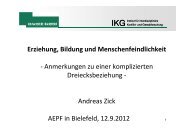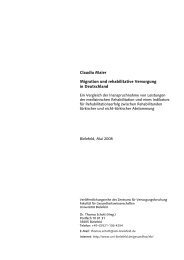POLITICS OF CONTEMPT, CASUALTY AND CULPABILITY ...
POLITICS OF CONTEMPT, CASUALTY AND CULPABILITY ...
POLITICS OF CONTEMPT, CASUALTY AND CULPABILITY ...
You also want an ePaper? Increase the reach of your titles
YUMPU automatically turns print PDFs into web optimized ePapers that Google loves.
The Maoists are perhaps rejoicing with their success by “razing the city of God to the<br />
ground”, as long dreamed by Karl Marx, to overlord the Nepali State that would again be<br />
founded on terror. 9 It therefore leads me to recall what Albert Camus wrote 56 years ago:<br />
“All modern revolutions have ended in a reinforcement of the power of the state”. 10<br />
Marx’s interpretation of history, according to Camus, is that when it [men] is [are]<br />
“deprived of power, it [they] expresses itself [themselves] in revolutionary violence; at<br />
the height of its power, it risks becoming legal power, in other words, terror and trial”. 11<br />
Presently, the Maoists are bargaining for their best from within the government and by<br />
fielding unrestrained prowess of the Young Communist League (YCL) as ‘urban<br />
guerrillas’ in the streets. The Maoist ministers have even threatened to quit the<br />
government on the issue of change of guard to their security. 12 The Maoist Chairman<br />
claims that the army is more powerful than the prime minister. 13 The Maoist leaders have<br />
also complained that the country is run by India and the United States, not by the<br />
government of Nepal. Notwithstanding this, they have unashamedly stayed in the<br />
government enjoying state perks and privileges. The Maoist leaders have become<br />
infamous for their incredible public utterances. Though their credibility has dipped as<br />
their image has never been resonant, they are still indispensable forces in the transitional<br />
politics with anticipated cooperation on issues related to elusive peace and stability, albeit<br />
prevalent anarchy. The Maoists who had acted as counter-elites and optimized the<br />
prospect of change are also behaving in the way as the leaders of their partners in<br />
government. Hence the challenge that Nepal faces is holding leaders accountable for their<br />
deeds making the rule of law to prevail.<br />
Although the first act committed by the SPA government is a rupture in history, this<br />
process to come was already signaled and foreshadowed by disfiguring of the statue of<br />
Prithivi Narayan Shah during the Jana Andolan II demystifying the icon of the dynastic<br />
legitimacy of the Shah rulers. That was a sheer vandalism committed in an act of fury by<br />
the people, but the same act demonstrates the truth that the people have refused to coexist<br />
with the past. The decision that the SPA government had taken to bury the ‘glorious past’<br />
is therefore a continuity of a revolutionary situation fraught with violence in which the<br />
people are immerse with. Derrida views such a situation as ‘future anterior’. Accordingly,<br />
he opines, “All revolutionary situations, all revolutionary discourses, on the left or on the<br />
right justify the recourse to violence by alleging the founding, in progress or to come, of a<br />
new law. As this law to come will in return legitimate, retrospectively, the violence that<br />
may offend the sense of justice, its future anterior already justifies it.” 14 The destruction<br />
of the concept of self-immanence of the monarchical order central to the constitutive<br />
principles of the Nepali State is critical in the political repertoire of the renewal of the<br />
margins in the nation building enterprise.<br />
Dissecting with history is indeed a painful process, however. History is a fact of life. It is<br />
not only related to the genealogy of a community or a state, it is also a narrative of the<br />
community or a state on the basis of which the present is founded. Thus history is integral<br />
to the memory of a community with sentiments and symbols and with the construction of<br />
culture in identifying the self and the others. The present at creation has a historical past.<br />
It lives subconsciously in the memory of the people that guides their momentous<br />
4


